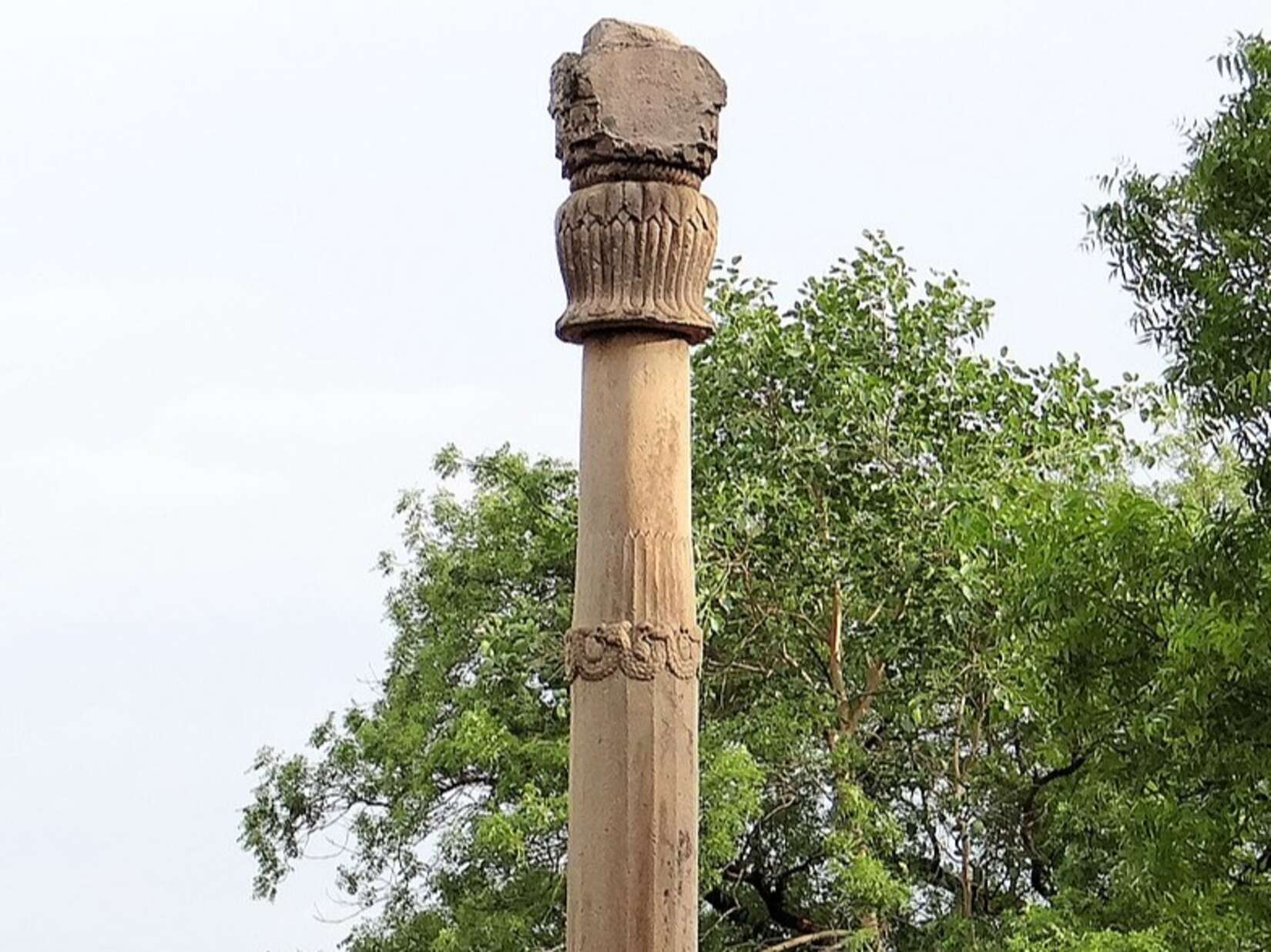

The Heliodorus Pillar in central India is a religious column with a Sanskrit inscription dedicated to Hindu deities that bears the name of a Greek ambassador from over two thousand years ago. At first glance, the appearance of Greek names carved into an ancient South Asian script naturally stirs great excitement and curiosity.
But why are Greek names on an ancient Hindu column anyway, and what does that tell us?
The pillar was first found in 1877 by British engineer and archaeologist Alexander Cunningham near the ancient city of Besnagar at the junction of the Betwa and Halalia rivers.
At the time, locals coated the column so thickly in a red paste—used in animal sacrifice rituals—that the coating hid much of its detail. Villagers considered the pillar sacred and called it Khamba Baba or Kham Baba.
Despite the lack of visible inscriptions, Cunningham had a hunch. The shape and faint emblems, including a coronation symbol, were suggestive of historical importance. He later described it as “the most curious and romantic” of his finds. His suspicions deepened when he discovered two additional pillars less than a mile away possibly related to the original one.
There was nothing further on this until 1909 to 1910, when a new archeological team led by H.H. Lake returned and began removing the red paste. To everyone’s surprise, they uncovered inscriptions in Brahmi, an ancient South Asian script.
Even more surprisingly, the main inscription named a man, Heliodorus, a 2nd-century BC Greek ambassador in India, along with a dedication to the Hindu deity Vāsudeva. A smaller inscription nearby listed human virtues later found to match the Mahabharata, one of India’s great Sanskrit epics.
This odd combination of Hellenistic and Hindu elements sparked deeper interest, leading to further excavations.
The first inscription describes the private religious dedication of Heliodorus (Translation by Richard Salomon) :
This Garuda-standard of Vāsudeva, the god of gods was constructed here by Heliodora (Heliodoros), the Bhagavata, son of Dion, a man of Takhkhasila (Taxila), the Greek ambassador who came from the Great King Amtalikita (Antialkidas) to King Kasiputra Bhagabhadra, the Savior, prospering in (his) fourteenth regnal year.
The first major excavation (1913–1915) was never completed. A local priest had built his home on a mound next to the pillar and refused to allow any digging, claiming it as his personal property. Still, archeological researchers led by Dattatraya Balakrishna Bhandarkar and M.D. Khare found evidence of repeated flooding over the past two thousand years, which had deposited thick layers of mud.
They also discovered a large rectangular structure and other ruins, indicating that the pillar was once part of a vast religious site. A fourth excavation (1963–1965) brought better results. The priest had been removed and his house demolished. Underneath, they found brick foundations for an elliptical temple and its halls. In digging deeper, they even found the foundations of an older temple.
As researchers removed the accumulated mud and silt, they realized the pillar’s base extended much deeper than initially believed. This was due to rising ground levels over centuries of floods, which required new foundation layers to support the structure. Eventually, the archeologists realized that the Heliodorus Pillar was one of eight columns that aligned to form a grand north-south temple complex.

The Heliodorus Pillar stands as a striking testament to early Indo-Greek religious and diplomatic engagement. The original Garuda capital atop the pillar has not survived. However, it may have unknowingly been recovered by Alexander Cunningham and transferred to the Gwalior Museum. A statue fragment there depicting bird talons gripping a serpent atop part of a vedika could be a possible remnant of this lost capital.
Art historian Susan L. Huntington suggests the pillar’s capital likely resembled the Garuda standards seen in Bharhut reliefs from the same period. One such relief depicts a horseman bearing a pillar crowned by a bird-man figure akin to Garuda or a Kinnara. Intriguingly, a resident of Vidisha dedicated this relief, further supporting the idea that the Bharhut carving may reflect or replicate the design of the Heliodorus Pillar’s original Garuda capital.
The Brahmi inscription accompanying the Bharhut relief reads: “Vedisiri bhichuno danam” (“Gift of the monk Vedisiri”).

One reason the pillar is so significant is because it marks one of the earliest known instances of a Westerner (Heliodorus) making a sacrifice to a Hindu deity. This implies that he may have converted to Vaishnavism, one of the major branches of Hinduism.
However, scholars such as Harry Falk are not convinced that this was a true religious conversion. The dedication could have been a diplomatic gesture, paying respect to local traditions—a common duty of ambassadors like Heliodorus.
Falk also points to Greek religious custom, whereby it was common to honor foreign deities while abroad, even in India. Rather than abandoning Greek religion, Heliodorus may have simply added Vāsudeva to his personal pantheon.
Although the Greek name sparked interest, the pillar’s greatest value lies elsewhere. It offers a fixed chronological anchor in the reign of Indo-Greek King Antialkidas (c. 115–80 BC). This makes the pillar an essential reference point for dating other Indian art and architecture—especially Buddhist complexes such as the nearby Sanchi.
